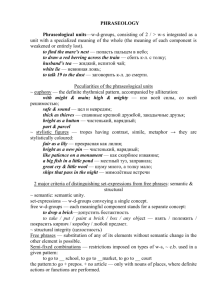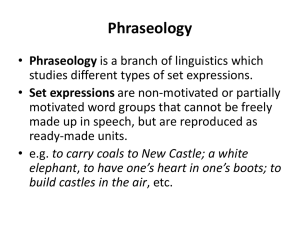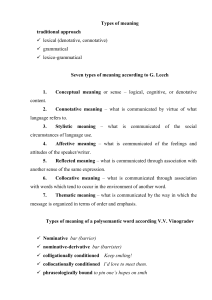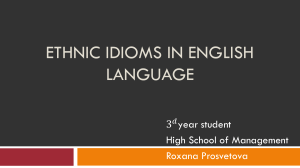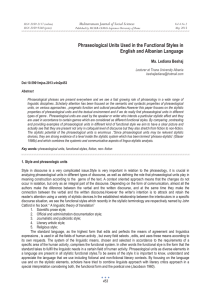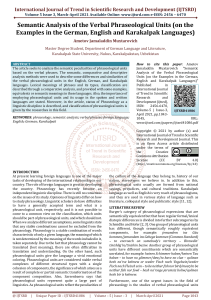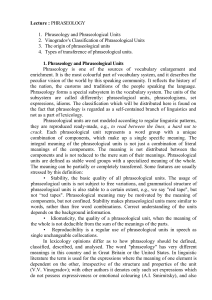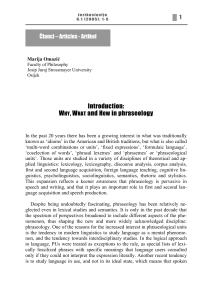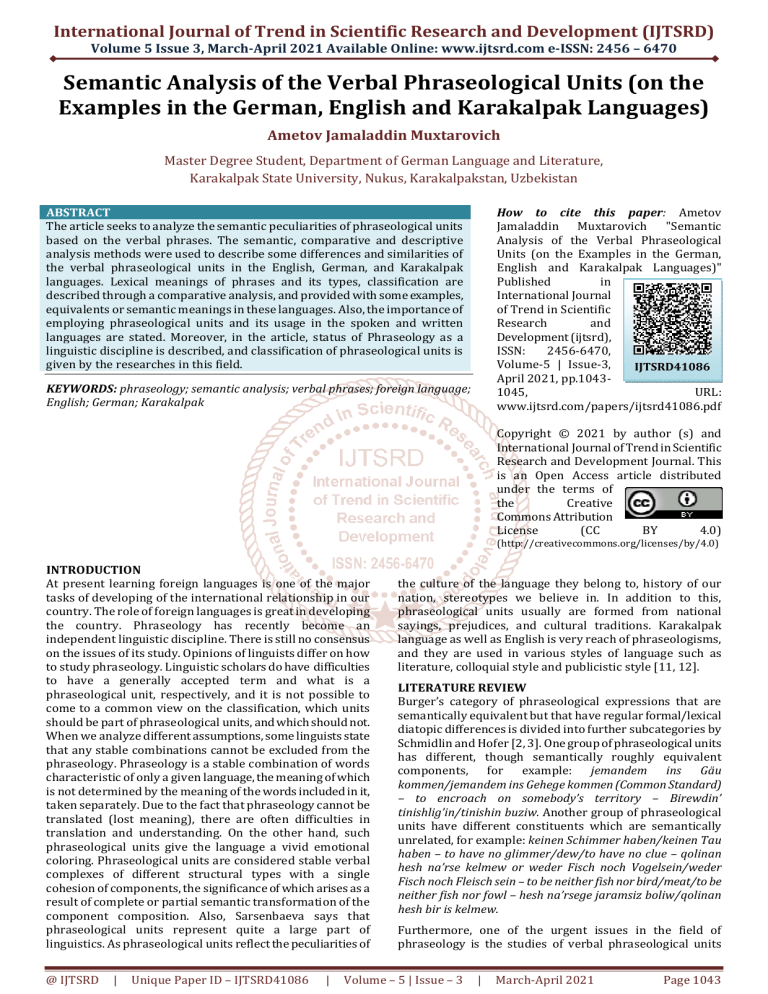
International Journal of Trend in Scientific Research and Development (IJTSRD)
Volume 5 Issue 3, March-April 2021 Available Online: www.ijtsrd.com e-ISSN: 2456 – 6470
Semantic Analysis of the Verbal Phraseological Units (on the
Examples in the German, English and Karakalpak Languages)
Ametov Jamaladdin Muxtarovich
Master Degree Student, Department of German Language and Literature,
Karakalpak State University, Nukus, Karakalpakstan, Uzbekistan
How to cite this paper: Ametov
Jamaladdin Muxtarovich "Semantic
Analysis of the Verbal Phraseological
Units (on the Examples in the German,
English and Karakalpak Languages)"
Published
in
International Journal
of Trend in Scientific
Research
and
Development (ijtsrd),
ISSN:
2456-6470,
Volume-5 | Issue-3,
IJTSRD41086
April 2021, pp.10431045,
URL:
www.ijtsrd.com/papers/ijtsrd41086.pdf
ABSTRACT
The article seeks to analyze the semantic peculiarities of phraseological units
based on the verbal phrases. The semantic, comparative and descriptive
analysis methods were used to describe some differences and similarities of
the verbal phraseological units in the English, German, and Karakalpak
languages. Lexical meanings of phrases and its types, classification are
described through a comparative analysis, and provided with some examples,
equivalents or semantic meanings in these languages. Also, the importance of
employing phraseological units and its usage in the spoken and written
languages are stated. Moreover, in the article, status of Phraseology as a
linguistic discipline is described, and classification of phraseological units is
given by the researches in this field.
KEYWORDS: phraseology; semantic analysis; verbal phrases; foreign language;
English; German; Karakalpak
Copyright © 2021 by author (s) and
International Journal of Trend in Scientific
Research and Development Journal. This
is an Open Access article distributed
under the terms of
the
Creative
Commons Attribution
License
(CC
BY
4.0)
(http://creativecommons.org/licenses/by/4.0)
INTRODUCTION
At present learning foreign languages is one of the major
tasks of developing of the international relationship in our
country. The role of foreign languages is great in developing
the country. Phraseology has recently become an
independent linguistic discipline. There is still no consensus
on the issues of its study. Opinions of linguists differ on how
to study phraseology. Linguistic scholars do have difficulties
to have a generally accepted term and what is a
phraseological unit, respectively, and it is not possible to
come to a common view on the classification, which units
should be part of phraseological units, and which should not.
When we analyze different assumptions, some linguists state
that any stable combinations cannot be excluded from the
phraseology. Phraseology is a stable combination of words
characteristic of only a given language, the meaning of which
is not determined by the meaning of the words included in it,
taken separately. Due to the fact that phraseology cannot be
translated (lost meaning), there are often difficulties in
translation and understanding. On the other hand, such
phraseological units give the language a vivid emotional
coloring. Phraseological units are considered stable verbal
complexes of different structural types with a single
cohesion of components, the significance of which arises as a
result of complete or partial semantic transformation of the
component composition. Also, Sarsenbaeva says that
phraseological units represent quite a large part of
linguistics. As phraseological units reflect the peculiarities of
@ IJTSRD
|
Unique Paper ID – IJTSRD41086
|
the culture of the language they belong to, history of our
nation, stereotypes we believe in. In addition to this,
phraseological units usually are formed from national
sayings, prejudices, and cultural traditions. Karakalpak
language as well as English is very reach of phraseologisms,
and they are used in various styles of language such as
literature, colloquial style and publicistic style [11, 12].
LITERATURE REVIEW
Burger’s category of phraseological expressions that are
semantically equivalent but that have regular formal/lexical
diatopic differences is divided into further subcategories by
Schmidlin and Hofer [2, 3]. One group of phraseological units
has different, though semantically roughly equivalent
components, for example: jemandem ins Gäu
kommen/jemandem ins Gehege kommen (Common Standard)
– to encroach on somebody’s territory – Birewdin’
tinishlig’in/tinishin buziw. Another group of phraseological
units have different constituents which are semantically
unrelated, for example: keinen Schimmer haben/keinen Tau
haben – to have no glimmer/dew/to have no clue – qolinan
hesh na’rse kelmew or weder Fisch noch Vogelsein/weder
Fisch noch Fleisch sein – to be neither fish nor bird/meat/to be
neither fish nor fowl – hesh na’rsege jaramsiz boliw/qolinan
hesh bir is kelmew.
Furthermore, one of the urgent issues in the field of
phraseology is the studies of verbal phraseological units
Volume – 5 | Issue – 3
|
March-April 2021
Page 1043
International Journal of Trend in Scientific Research and Development (IJTSRD) @ www.ijtsrd.com eISSN: 2456-6470
(PUs) as the verb is considered to be the nuclear of utterance
[7, p. 229-324]. Verbal PUs are classified into nominative and
nominative-communicative units, due to the fact that some
of them have the form of phrases, while others may have the
form of both phrases and sentences [10]. Verbal PU can be
completely or partially motivated or unmotivated word
combinations with a shift of meaning. Metaphor, metonymy
and comparison are the basic types of the shift of meaning.
Metaphorical PUs are often hyperbolic or euphemistic. Nonmotivation is caused by both linguistic and extra-linguistic
factors. In unmotivated word combinations with partial shift
of meaning the connection of the verbal component with
other PU components is not motivated. As a result of the
false etymology re-motivation of fusions may take place,
which is explained by the desire of the man to comprehend
the incomprehensible. Most verbal PUs refer to a person, to
actions committed by a person, or to the state in which the
person is located. PUs, unrelated to the man, are much less
common, for example: blow great guns (of the storm, the roar
of the storm is likened to thunder of artillery).
METHODOLOGY
Making a new phraseological unit from another
phraseological unit can be noted as phraseological
derivation. The isolation of phraseological phrases from the
composition of more complex phraseological units is one of
the ways of forming phraseological units. The newly formed
unit begins to live on its own, but its meaning is determined
by the semantics of the original phraseology. Thus the
unmotivated nature of the phraseological unit: The gray
mare means The wife holding her husband under the shoe is
explained by the motivation of the proverb the gray mare is
the better horse – The wife who is a leader in the home from
which this PU was formed by separating the initial
components [5, 67]. Moreover, new phraseological units can
be formed by separating the initial final components of a
more complex phraseology. For example, from the proverb
The old birds are not to be caught with chaff formed two PE
An old bird 1) An old, shooting sparrow, and to be caught with
chaff - to be easily deceived [6, 36]. Moreover, phraseological
derivations include: 1) Conversion :from the noun form A
play with fire to the verb form To play with fire; 2) Study by
analogy: curiosity killed a cat – curiosity will not lead to good
the phrase was taken from Shakespearism to care killed a cat
– much care will not lead to the goodness; 3) The formation of
the verbal phraseological units from the proverb used in the
imperative mood: strike the iron while it is hot; 4) Expansion
of the phraseological units: As merry as a grig – means
cheerful, full of life was formed from obsolete phraseology a
merry grig – cheerful guy [6, 59]; 5) study by contrast: to
come off the high horse –to stop being too haughty on
phraseological unit to get on/ride/mount a high horse which
means to be arrogant. Thus, there are many ways of learning
phraseological units. The study of phraseology is important
both in the theoretical plan and in the practical as well, as it
contributes to the conscious assimilation of phraseological
units [1, 246].
There is also a type of phraseological units which are
connected with person or everything that is connected with
the person. These kinds of phrases are called
anthropocentric. They denote actions or statements, for
example: grasp the nettle means to manage everything
courageously in order to solve any problem, or to put all one’s
eggs in one basket means to bet all you have/to make a risk
[5, 43]. Sometimes the component or components of
@ IJTSRD
|
Unique Paper ID – IJTSRD41086
|
phraseological unit name any object or animal. However, the
meaning of it becomes referred to only human beings. For
example, a new broom means a new director or a big fish in a
little/small pond means the boss [6, 23]. The structure of
majority of the phrases that refer to a person, usually do not
consist of simple, different word groups, but of potential
phraseological units which are linked with unreal images.
For example, to have nine lives like a cat means to have
surprised ability to survive/ hard to be killed or like a bat out
of hell means too fast, wrestle with an angel means to fight
with very powerful rival [5, 23]. As a result, we may highlight
that not only phraseological units, but also their prototypes
refer to a person. Simple shift of phraseological units play
really great place for enlarging phraseological system of
contemporary English language.
RESULTS AND DISCUSSION
There are different ways of classifying phraseological units
[2, 3]. There is a necessity for the typology of items
borrowed from other languages that is based on the lexical
materials which phraseological units contain. Thus, we
employ Haugen’s and Weinreich’s classifications, and their
criteria of substitution and importation as a main point. Thus,
three main types of phraseological borrowings could be
differentiated [8]. The first group includes direct loans,
phrases and sentences that have been imported wholesale
from English (No pain, no gain; Meet and Greet; Blind Date).
On the other hand, there are some borrowings (in other
words: loan translations) that lexical material was fully
substituted by morphemes, German in this case. We can see
this in the following examples in the German, English and
Karakalpak languages: ein Problem adressieren - to address a
problem - qanday da bir qiyinshiliqqa jolig’iw. A further
distinction can be created as a result of relative similarity to
the original. While the examples mentioned above represent
rather close translations, phraseological units such as: 1) Gib
uns Süßes, sonst gibt’s Saures/Süßes oder Saures – Give us
something sweet, otherwise you’ll get something sour/trick or
treat – Atag’anin’di bermesen’ bizge, ashshinin’ da’min
tatasan’; 2) Wem es in der Küche zu heiß ist, der sollte nicht
Koch werden – if it’s too hot for you in the kitchen, you
shouldn’t become a cook/If you can’t stand the heat, get out of
the kitchen – Gu’ldi su’ygen, tikeninde su’yedi.
In Burger’s words, for about half of the phraseological
expressions typical of Swiss standard (for example:
phraseological Helveticisms), there are corresponding
expressions in German such as den Anschein machen/den
Anschein haben – To appear/give the impression of – Ko’rinis
beriw/Ta’sir qaldiriw. Also, Burger estimates the same
degree of relationship between phraseological expressions
typical of Austrian standard and Common German
expressions [2, 3. p. 196]. We can see this in the following
phrases: 1) etwas geht jemanden einen Schmarren an/etwas
geht jemanden einen Dreck an – something is none of one’s
damned business – O’zin’e tiyisli bolmag’an iske murnin’di
suqpa; 2) sich (selber) an der Nase nehmen/sich an die Nase
fassen (Germany) - to take/touch one’s own nose/to take a
good look at oneself (instead of criticizing others) – Aldin
o’zin’e baq, keyin nag’ara qaq/O’zin’diki bolmag’an iske
aralaspa where variants could be grouped around the same
core word [9].
CONCLUSION
Thus, Phraseology is a section of linguistics that studies the
phraseological composition of language in its present state
Volume – 5 | Issue – 3
|
March-April 2021
Page 1044
International Journal of Trend in Scientific Research and Development (IJTSRD) @ www.ijtsrd.com eISSN: 2456-6470
and historical development. We assume that there may not
be single classification of phraseologisms of German, English
and Karakalpak, since scientists divide phraseological units
based on different principles: structure, semantics,
communicative function, etymology of phraseological units,
approaches to their translation into other languages. Using
phraseologisms, idioms in communication is a difficult
problem for people learning German, English languages as a
foreign one. Also, if people intentionally avoid using idioms,
in this case their oral and written speech, most likely, will be
dull and high-flown. So we consider this research to be quite
topical in this term of investigation. The sources of
phraseology attract the attention of many linguists who
investigate its matters in order to disclose them and
reveal their core information. Phraseological units can
accumulate socio-historical, intellectual, emotional
information of a specifically national character. It is these
facts that justify the choice of the topic of this thesis, its
relevance and significance for phraseology, lexicology in
particular and for philological science in general.
References
[1] Arnold I. V. Lexicology of Modern English: Textbook.
/For institutes and faculty of foreign languages/. 3rd
ed., Rev. and add. M.: Higher ed., 1986. 295 p.
Following C. Carballo, we can note that language is not
isolated, and it is a social and cultural tool, for this reason,
phraseological competence of a communicator depends to a
great extent on the cultural knowledge of the linguistic
system [4]. Thus, situational context really matters while
learning and it is the one that asks for specific utterances and
expressions that fit particular situations. Also, that context
may vary regarding traditions and conventions from one
language to another, so what in a community is an act of
courtesy or politeness may result offensive to a different
population. In this way, intercultural learning is also
promoted through these units. These special features of
languages and people should be explained and analyzed by
foreign language learners so that they are able to think
differently and immerse themselves into the foreign
language’s environment. As C. Carballo [4] defends, teachers
should never forget that cultural knowledge and phraseology
have to interrelate so that the students can become proper
users in the foreign language, since it might be stated that a
non-native speaker comes to master the target language
when he/she can encode and decode a significant number of
phraseological units.
@ IJTSRD
|
Unique Paper ID – IJTSRD41086
|
[2]
Burger, H. Phraseologie in den Wörterbüchern des
heutigen Deutsch. In: Germanistische Linguistik 14/82. Studien zur neuhochdeutschen Lexikographie
III. 1983.
[3]
Burger, H. Helvetismen in der Phraseologie. In:
Löffler, H. (ed.), Alemannische Dialektforschung.
Bilanz und Perspektiven. Tübingen. 1995. pp. 13-26.
[4]
Castillo Carballo, M. A. Conocimiento cultural en la
adquisición de la L2: La Fraseología. El español,
lengua del mestizaje y la interculturalidad. Actas XIII
(Centro Virtual Cervantes). 2002.
[5]
Dagut, M. Avoidance of Phrasal verbs: a case for
contrastive analysis, Studies in second language
acquisition. London: 7. 1985. pp. 73-79.
[6]
English – Russian dictionary of more useful
phraseological expressions. М.: Yakhont, 2001, 340 p.
[7]
Fedulenkova, T. N. English Phraseology: A Course of
Lectures. Arkhangelsk. 2000. pp. 229-324.
[8]
Fiedler, S. Phraseological borrowing from English into
German: Cultural and pragmatic implications. Journal
of
Pragmatics,
2017.
http://dx.doi.org/10.1016/j.pragma.2017.03.002.
[9]
Hofer, L., Schmidlin, R. Phraseology and Lexicography:
fixed expressions in a dictionary of national variants
of Standard German. In: Allerton, D. J./ Nesselhauf, N./
Skandera, P. (eds.), Phraseological Units: basic
concepts and their application. Basel. 2003.
[10]
Kunin, A. V. Phraseology of modern English.
Publisher: International Relations. 1996. pp. 44-127.
[11]
Sarsenbaeva, Z. J., Utebaev, T. T. Role of phraseology
in developing communicative competence. EPRA
International Journal of Multidisciplinary Research
(IJMR) - Peer Reviewed Journal Volume: 6 | Issue: 9.
DOI: https://doi.org/10.36713/epra5111.
[12]
Sarsenbaeva, Z. J. Comparative analysis of
phraseological synonyms in English and Karakalpak
languages. Web of Scholar, 5(23), Vol.4, May, 2018.
Volume – 5 | Issue – 3
|
March-April 2021
Page 1045

